
After a turbulent start to the season, Conte’s men seem settled with their 3–5–2 revelation. It was a timely tweak made by the Italian that changed the season following a subpar start where the team looked bereft of creativity.
Ever since the shift to a dynamic 3–5–2, Chelsea have been wreaking havoc using their front two breaking away on the counter and also with their build-up play. Let us see how the Blues fare going forward in the 3–5–2 right from the base:
Build-up play
The build-up play is majorly based on the dynamism and movement from the midfielders and the front two. However, playing out from the back is extremely important for a team to arrive in the right positions for the coup de grâce. Without good build-up, it is almost impossible to have a good attack.
First, let's have a look at how the Blues work on playing out from the back.
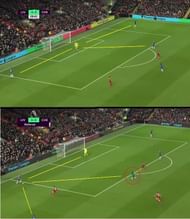
Azpilicueta and Cahill split wide to provide passing options to Courtois with Christensen in the middle.The 3 centre-backs spread out to make the pitch as wide as possible to avoid the first line of pressure from the opponents. The above example was from the 1–1 draw against Liverpool at Anfield. As you can see, Cahill and Azpilicueta split on to either side of Courtois with Christensen at the edge of the box. To ease the pressure, Kante is heading towards the box to give Courtois another option.
Courtois passes to Azpilicueta, who now has 3 options:
-Zappacosta to his right
-Kante (circled red) who has arrived to ease the pressure from the Liverpool front-line
- Return to Courtois who would in turn switch play to the other flank or go long.
However, building-up play with short-passing has been deployed more often against teams who don't press.
The following are the distribution statistics of Courtois with the 3-5-2 and 3-4-3 in 20 games (Premier League and UEFA Champions League combined)

The major reason for this is that Chelsea have deployed the 3-5-2 more against the tougher opponents in comparison to the 3-4-3 as it has provided more defensive diligence. The 3-5-2 was used first against Tottenham and then in the games Atletico Madrid, Manchester City, Manchester United, Liverpool and as the list suggests, the teams are tougher nuts to crack and apply high pressure during build-up play.
Conte, being the no non-sense manager he is, opts more of a no non-sense approach against these sides and hence the lesser risk of losing the ball near to goal is also a reason for more long balls. Given that Chelsea don't have many players who are physically commanding, Alonso becomes the default first option for Courtois for a long ball. Also, another reason being that the risk of losing the ball is negligible as it is on the flank and hence won't result in a possession change in the middle of the pitch.
Also read: Antonio Conte's 3-5-2: How do Chelsea defend?
This is where Alonso goes unnoticed as it is not often when your left wing-back would be winning about 2.5 aerial duels per game. To stress on the same even further, the world’s top left-backs namely Marcelo, Jordi Alba average approximately 0.4 aerial duels per game
The Belgian Brilliance
Moving on to the next phase of build-up, it is all about Eden Hazard. Let’s check it out:

As you can see, Hazard (circled red) drops deep during build-up play and enjoys a free role while Chelsea are on the attack. The Belgian can link up with Fabregas and act as the second playmaker or choose to overload the wing with Zappacosta or Alonso. He can receive, turn and have a go at the opposition defenders, shoot from long range, probably any decision which he feels at that moment of play.
It’s a very similar role to that of Lionel Messi in Barcelona, wherein he doesn’t have specific instructions while on the attack and can drop deep to receive the ball and make something happen.
If you take the example of the West Bromwich game when Chelsea humiliated them 0–4, the first 2 goals transpired courtesy of Hazard dropping deep. The first one was Hazard’s turn and shot from the final third that was parried by Foster and Morata waiting in the right area to tap the rebound.
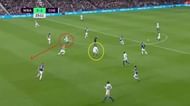
The second goal was also a classic come short and create a bit of doubt among the Baggies defenders. Hazard (circled red) dropped deep along with Morata (circled yellow). West Bromwich’s defence was not really sure if they could maintain distance or go high-line and stay tight with Chelsea’s front two.
Before the defenders went tight or retreated, Fabregas spoted the opportunity to play Morata, who flicked it on the first time of asking as he knew without even looking back, to put the Belgian 1v1 with the goalkeeper, 0–2!
The third man
This is probably what Conte’s 3–5–2 is all about, an additional midfielder instead of a man in the forward line in the form of Pedro or Willian. Bakayoko has been deployed as the destroyer in the midfield three alongside Fabregas and Kante but his role isn’t limited to making tackles, out-muscling the opponents and adding energy to the midfield.
With Hazard being pulled back to help in the build-up play, the former Ligue 1 star pushes up to position himself alongside Morata almost as another attacker.
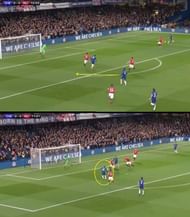
The above picture is something that could probably be etched in all of the Chelsea fans' heart as most of them would have been jumping off their seat by the time Bakayoko had taken the shot but his wasteful finishing kept the score at 0-0. This is the role that the additional midfielder in Bakayoko has been doing and that is to push up and be a forward when the opportunity arises.
Morata missed the cross and Bakayoko arrived perfectly just outside the 6-yard box but he failed to convert. One may wonder if the same thing would have happened if Hazard was a different sort of a player. Yes, at the end of the day, Chelsea are creating more chances with Hazard falling into a deeper role at times, but Bakayoko isn't the player you'd want in the box considering how bad his finishing is.
Here’s another example in the game against West Bromwich:
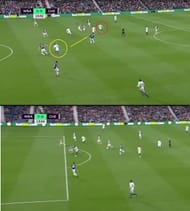
Here, Fabregas is on the ball after a quick link-up play with Hazard (circled red). The Belgian is positioned deep in midfield to help Chelsea create and Bakayoko (circled yellow) doesn’t think twice to push forward and become the additional attacker. But yet again, Bakayoko's poor finishing let him down and the movement and link-up play were in vain.
If the young Frenchman can improve this particular aspect of his game, then it is going to be a pleasant surprise for the Blues to have a central-midfielder on the score-sheet more often than not. However, with the impressive performances of Drinkwater on his return, the third position in midfield is there for the taking and Bakayoko really needs to up his game to compete.
La Roja: The new core of Chelsea?
It looks like Alvaro Morata isn’t the only Spaniard to have made a mark in the current campaign for Chelsea. Ever since the revelation of the 3–5–2, Cesc Fabregas has really picked himself up and hit a purple patch. The most obvious reason for this has been the reduced defensive load on him with the additional midfielder starting next to him and Kante. Be it Bakayoko or Drinkwater, the Chelsea midfield looks to be an almost perfect combination of steel and silk.
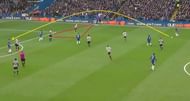
The goal constructed by the Spanish duo against Manchester United is a memorable one and this example is from the game against Newcastle United when the Blues triumphed 3–1.
As you may see, the trio of Fabregas, Hazard and Moses (red triangle) overload the right side and as a result occupy all of Newcastle’s defenders on that flank, allowing space for Azpilicueta to charge forward. An additional midfielder in Kante means that any Newcastle player who wants to step out and close down Azpilicueta might risk leaving his man in a more dangerous zone, free to receive a pass.
The overload on the right to allow him space has become a pattern and the Blues have executed it to perfection numerous times out of which at least 4 times, Conte’s men have found the back of the net.
Conclusion
Apart from all of the above-mentioned routes that can be taken, the Blues have also been prolific breaking away on the counter with the front two. With the 3–4–3, there were occasions when Morata would be left without support as both wingers would track back to defend.
With the 3–5–2, Morata and Hazard can combine well and the freedom Fabregas enjoys with the defensive duties shared among 2 other midfielders adds more creativity. This has allowed him to quickly get to the position from where he releases the front two with his sublime passing range and in turn, unlock opposition defences.
Images source: www.fullmatchreplay.com
